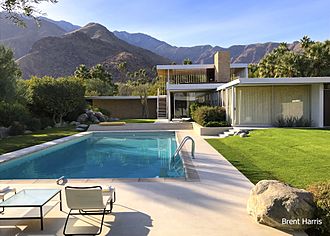Kaufmann Desert House facts for kids
Quick facts for kids Kaufmann Desert House |
|
|---|---|

Kaufmann Desert House, December 2017
|
|
| General information | |
| Status | Complete |
| Architectural style | International Style |
| Location | 470 West Vista Chino Palm Springs, California United States |
| Coordinates | 33°50′42″N 116°33′10″W / 33.8451°N 116.5529°W |
| Completed | 1946 |
| Design and construction | |
| Architect | Richard J. Neutra |
The Kaufmann Desert House is a famous house in Palm Springs, California. It was designed by the architect Richard Neutra in 1946. A businessman named Edgar J. Kaufmann, Snr asked Neutra to build it. This same businessman also asked Frank Lloyd Wright to design another famous house called Fallingwater.
The Kaufmann Desert House is known as an amazing example of Modernist architecture. It helped define the modern look of Palm Springs. The city of Palm Springs has even named it a Class 1 Historic Site.
Contents
History of the Kaufmann House
The Kaufmann Desert House was built in 1946. Edgar J. Kaufmann, who owned a large department store, wanted a warm place to escape the cold winters. He chose Palm Springs for his desert home.
How the House Became Famous
The house became very well known thanks to stunning photographs. Julius Shulman took famous pictures of it in 1947. Later, in 1970, Slim Aarons took another iconic photo called "Poolside Gossip."
Changes Over Time
After Mr. Kaufmann passed away in 1955, the house was empty for a while. Then, different people owned it, including singer Barry Manilow. Over the years, some owners made changes to the house. For example, they closed off an outdoor patio and added new wallpaper. They even changed the roof to add air conditioning. These changes made the house look different from Neutra's original design.
Bringing the House Back to Life
In 1992, a couple named Brent Harris and Beth Edwards Harris bought the house. They were very interested in architecture. They wanted to bring the house back to its original look. This was a big project that took five years, starting in 1993.
To find out how the house originally looked, the Harrises did a lot of research. They looked through Richard Neutra's old drawings and papers at UCLA and Columbia University. They even worked with photographer Julius Shulman to see some of his never-before-seen photos of the house's inside.
They found the original companies that supplied the paint and other parts for the house. They even bought a special machine to make the metal trim (called a fascia) that went along the roof, just like the original.
Restoring the Landscape
The Harrises also wanted to restore the natural desert setting around the house. They even had a part of a quarry (a place where stone is dug) in Utah reopened. This allowed them to get the exact same type of stone that was used when the house was first built.
To make the house feel like it was truly in the desert again, they bought more land next to it. This made the property much bigger. They also rebuilt a small building by the pool, which is now a great spot to view the main house. A tennis court that was added later was kept.
Recent Sales and Recognition
After the Harrises divorced, the house was put up for auction in 2008. It was expected to sell for a lot of money, between US$15 million and US$25 million. It sold for US$15 million, but the sale didn't go through. The house was listed for sale again in 2008 and 2020.
In 2008, the Kaufmann Desert House was named one of the top 10 houses in Los Angeles by experts, even though it's in Palm Springs. This shows how important and famous this house is in the world of architecture.
See also
 In Spanish: Kaufmann Desert House para niños
In Spanish: Kaufmann Desert House para niños

